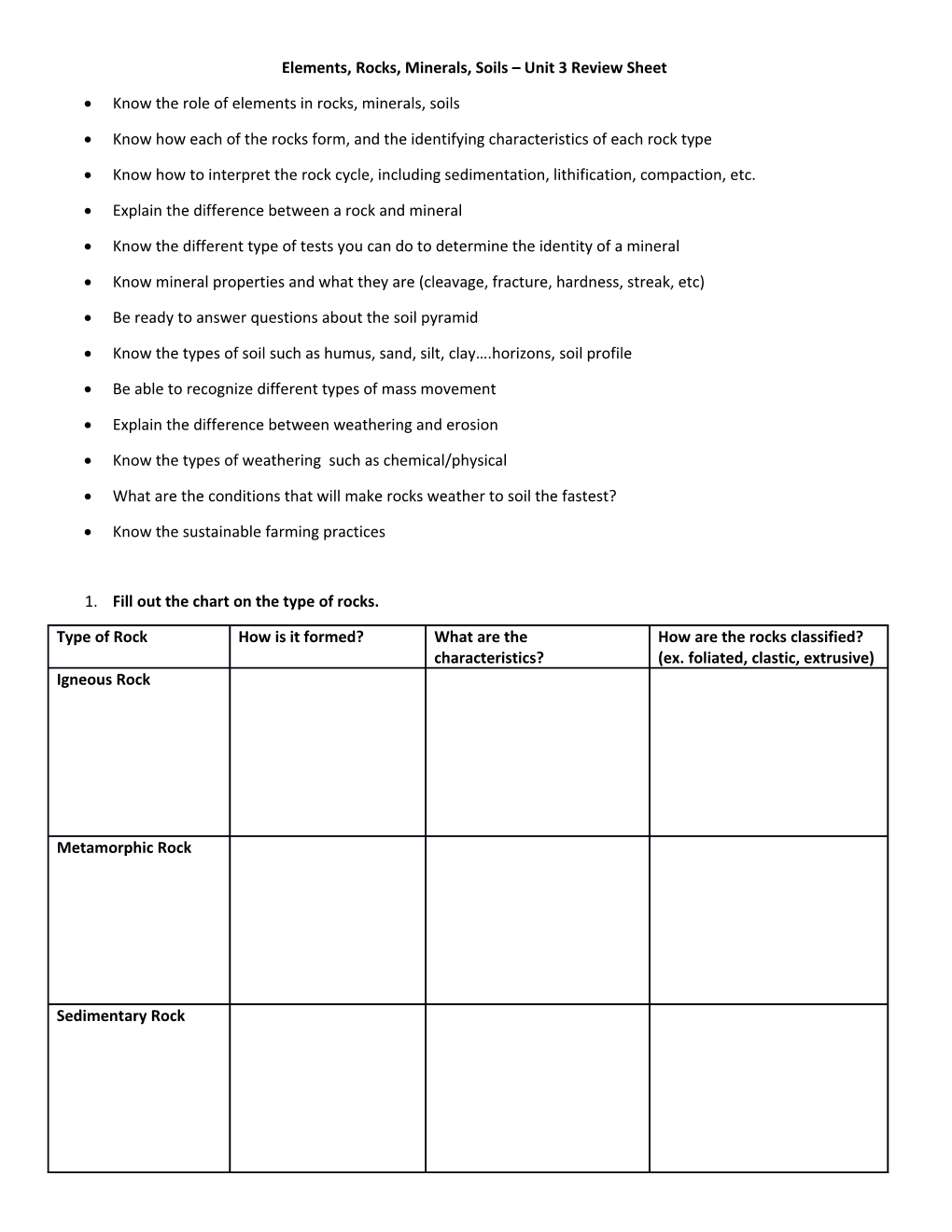Elements, Rocks, Minerals, Soils – Unit 3 Review Sheet
- Know the role of elements in rocks, minerals, soils
- Know how each of the rocks form, and the identifying characteristics of each rock type
- Know how to interpret the rock cycle, including sedimentation, lithification, compaction, etc.
- Explain the difference between a rock and mineral
- Know the different type of tests you can do to determine the identity of a mineral
- Know mineral properties and what they are (cleavage, fracture, hardness, streak, etc)
- Be ready to answer questions about the soil pyramid
- Know the types of soil such as humus, sand, silt, clay….horizons, soil profile
- Be able to recognize different types of mass movement
- Explain the difference between weathering and erosion
- Know the types of weathering such as chemical/physical
- What are the conditions that will make rocks weather to soil the fastest?
- Know the sustainable farming practices
- Fill out the chart on the type of rocks.
Type of Rock / How is it formed? / What are the characteristics? / How are the rocks classified? (ex. foliated, clastic, extrusive)
Igneous Rock
Metamorphic Rock
Sedimentary Rock
- Fill out the chart on how to classify minerals.
Color / Ex. Black
The tendency to break unevenly. / Ex.
Streak Color / Ex. Yellow
The ability to reflect light. / Ex.
Ex. Mohs Scale is 6 because it can be scratched by glass.
Cleavage / Ex.
Density / Ex. A quartz is heavier than talc.
- What are some unusual characteristics of minerals? (Hint: Halite & Magnetite)
______
- Fill out the blanks found on the rock cycle.
- What is the difference between a rock and a mineral?
- Rock:
- Mineral:
- Determine if the descriptions are examples of mechanical or chemical weathering.
- Limestone dissolved by carbonic acid ______
- The oxidation of minerals that contain iron ______
- A large rock falling from a cliff and then breaking ______
- Tree roots cracking the concrete foundation of a house ______
- Formation of potholes in streets during severe winters ______
- Match the terms to their definitions.
____a. Physical weathering caused by the action of freezing water A. chemical
____b. Physical weathering caused by roots. B. weathering
____c. When carbon dioxide and water combine chemically C. root wedging
____d. Type of weathering without change in chemical composition D. carbonic acid
____e. Type of weathering with a change in chemical composition E. leaching
____f. Process in which minerals are dissolved in water and carried downward F. physical
____g. The breaking down of rocks G. frost wedging
____h. The removal and transport of worn rocks and sediment. H. Deposition
____i. The deposit or stopping point for worn rocks and sediment. I. Erosion
- Explain each type of mass movement. What is responsible for mass movement? ______
- Slump:
- Creep:
- Rockslide/landslide:
- Mudflow:
- Circle the correct answer in each statement about the rate of erosion.
- Rocks weather fastest in (hot / cold) as well as (wet / dry) climates.
- Rocks weather slowest on a (flat area / slopped area).
- Rocks weather fastest when a (larger / smaller) surface area is exposed.
- Fill out the chart on soil texture.
Soil Type / Particle Size / Texture / Water filtration or leaching ability
Clay
Sand
Silt
- Use the soil triangle to answer the questions.
- Be able to identity and describe each soil horizon.
- Fill out the chart on agriculture.
Type of Agriculture / What is it? / Pros / Cons
Organic Farming
Crop Rotation
Terracing /Contour
- What is sustainable farming?
- Give examples of sustainable farming practices.
- ______
- ______
- ______
